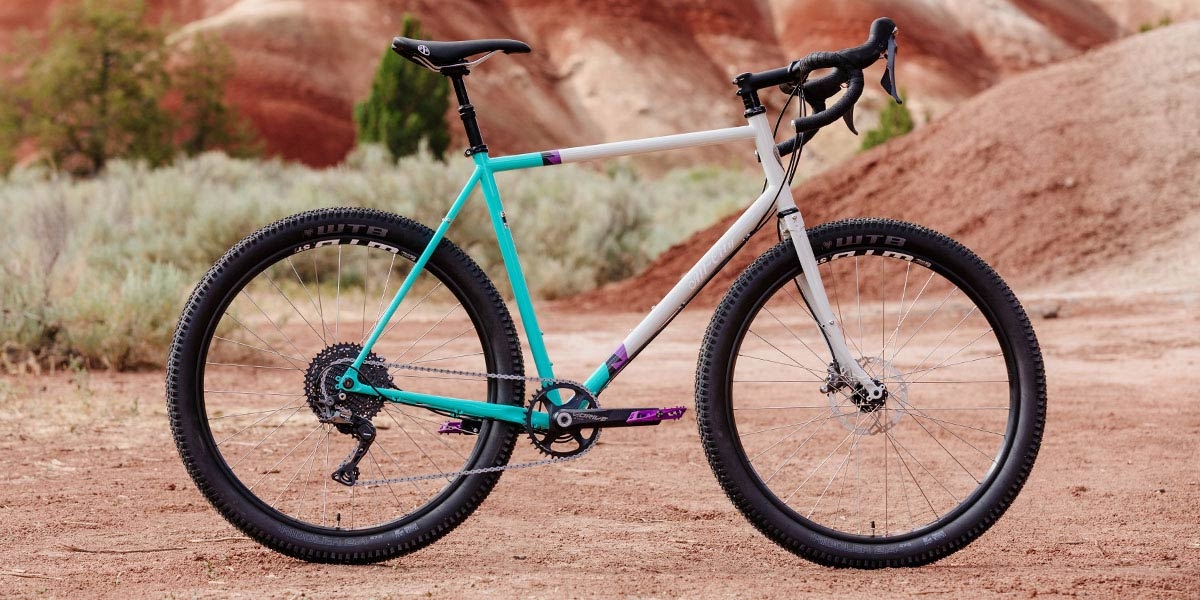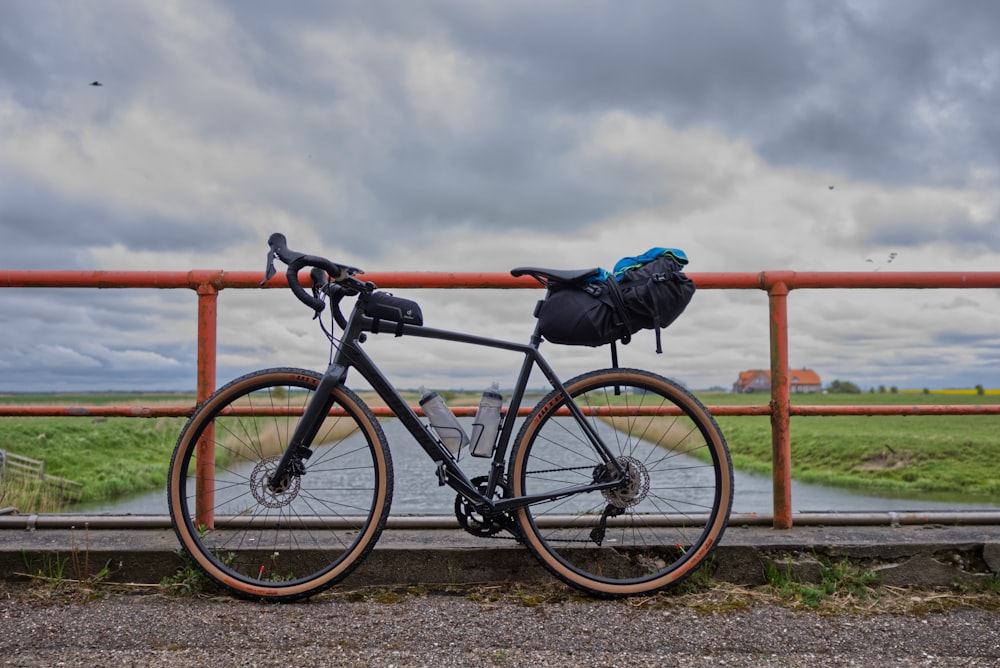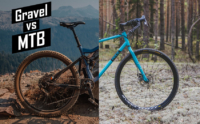Complete Gravel Biking Guide — Everything to Know Before Hitting Gravel

Gravel biking is one of the fastest-growing cycling disciplines. Although riding on gravel isn’t new, the exciting bicycles and riding style have exploded in popularity, both recreationally and competitively.
Modern gravel bikes are incredibly versatile and capable. Your gravel bike can do almost anything you throw at it and is personalizable for any job. As a result, they open up a world of possibility and adventure.
Below, we explain what riding gravel is, take you through its history and development, highlight the skills to practice, and finish with tips on bike setup and gear to succeed in gravel cycling.
What is Gravel Biking?

Canyon Grizl gravel bike. (Image source: Canyon.com)
Riding gravel sounds pretty specific, but it’s arguably the most diverse biking style. The modern definition of gravel biking involves using a gravel bicycle to tackle a mix of tarmac, unpaved roads, and forest and mountain trails.
This style mixes road and mountain biking and typically involves long-distance endurance-style rides on diverse yet not too extreme terrain. In addition, bikepacking, adventure riding, and bicycle touring are all increasingly linked with the gravel discipline.
Competitive gravel racing involves enormous distances of 100 to 200+ miles, ridden primarily on gravel paths with some roads and trails mixed in. These events usually allow limited support at specified checkpoints, meaning riders must carry most of their sustenance and repair equipment.
The characteristics that define gravel riding, broadly speaking, are versatility and adventure. For this reason, the bikes perform well on all terrains, they’re super comfortable to ride over long distances, and they can adapt to suit the job you need, such as carrying gear and fitting varied tire/wheel sizes.
Looking for a gravel bike? Check out these guides!
- Best Cheap Gravel Bikes under $2,000
- Best Steel Gravel Bikes
- Best Women’s Gravel Bikes
- Best Electric Gravel Bikes
(A Very Short) History of Gravel Biking
To better answer the question, “what is gravel biking?” it helps to understand what came before the modern discipline.
Early Bicycling

One of the competitors in a 1936 Tour de France race.
Firstly, it’s worth mentioning that almost all early cycling and road racing happened on rough, gravelly surfaces, so early bicycles had to be capable of riding on them. This is because the widespread construction of smooth, paved road surfaces occurred throughout the early 20th century alongside the proliferation of the automobile.
Improvement in road quality led to greater specialization, with road bikes taking advantage of the speed gains offered by narrower, smoother, and lighter tires.
Modern Biking
Jumping forward a few decades, in the ’70s, the mountain bike was developed and popularized, establishing two distinct and contrasting cycling disciplines: road and mountain biking.
These two specialized riding styles sat neatly at either end of a spectrum, between which you had fringe activities like adventure riding, bicycle touring, and cyclocross (short off-road races on grass, mud, and sand).
The development of the gravel bike was a response to the demand for a more versatile all-terrain bike to fill the gap between mountain and road. Although cyclocross bikes offer more off-road capability than road bikes, their use is still quite specific given design limitations imposed by the UCI (competitive cycling’s organizing body).
In 2012, Salsa Cycles developed the first gravel bike—Warbird—in response to the demands of gravel racing. Modern gravel bikes are designed with the characteristics of cyclocross bikes, endurance road bikes, and mountain bikes to create the ultimate versatile machine. Stability, comfort, and efficiency are carefully balanced to ensure performance across various terrains.
Further Developments in Gravel Tech

AllCity Cycles Gorilla Monsoon with extra-wide tires.
A key cycling tech innovation that led to the development of gravel bikes is the disc brake. Placing the brake at the wheel axle allowed manufacturers to build incredibly diverse frames. As a result, modern gravel bikes can accommodate 650b and 700c wheels and tires as wide as 2.2″ (56mm).
Other developments specific to gravel bikes include:
- Gravel drop bars that are wider with flared drops to improve stability and control off-road
- Groupsets with ratios and characteristics suited to gravel riding
- Low-travel suspension components (up to 50mm)
These innovations and others are helping to boost the popularity of gravel bikes and cement the identity of the gravel category. However, gravel bikes remain largely undefined, so there is increasing diversity in the designs of the individual models.
Why is Gravel Biking So Popular?
We believe that gravel cycling is so popular due to the sense of freedom and adventure it provides. Gravel bikes can safely ride on almost any terrain, go pretty fast on roads (with narrower tires), carry lots of cargo, and they’re comfortable to ride for many hours.
This capability removes limitations and opens up endless opportunities to explore and enjoy the outdoors, appealing to a broad range of recreational cyclists, bikepackers, bicycle tourers, and competitive gravel racers.
Why Get a Gravel Bike
The reason to get a gravel bike over a hardtail mountain bike or endurance road bike isn’t always apparent. Yes, it’s possible to do gravel-style rides with these other bikes, but it doesn’t mean it’s ideal.
Mountain bikes aren’t ideal for long distances on mixed terrain as the upright position and suspension reduce efficiency, and the flat handlebars limit you to a single hand position. Likewise, even the best road bikes are unstable and inefficient on anything bumpier than light gravel.
Conversely, gravel bicycles aren’t specialized in one specific domain. Instead, they perform well on all but the most extreme terrain. In addition, the frames can fit many wheel/tire sizes and a variety of accessories like bags and racks, making them ideal for supported trips.
Can Gravel Bikes Really Do it All?
No, gravel bikes can’t do it all. We’ve established that gravel bikes are highly versatile and can comfortably tackle a variety of terrains. However, they meet their limits at either end of the spectrum.
We wouldn’t recommend using a gravel bike to tackle advanced singletrack or downhill mountain biking trails. They aren’t capable of handling large obstacles and tight, technical downhill riding.
Gravel bicycles also struggle to keep up with road bikes on paved surfaces, so leave competitive road riding to the specialist road bike.
However, they can do everything in between these two extremes really well, so if you want a bike that can do a little bit of everything, the gravel bike is your friend.
Can You Ride Road Bikes on Dirt and Gravel?

The Strade Bianche road race on hard-packed gravel roads.
Yes, you can ride road bikes on dirt and gravel. The Strade Bianche road cycling race on the white gravel roads of Tuscany, Italy, is a road cycling race that highlights this.
This race is 110-miles long, with roughly 40 miles on gravel paths, and the road bicycles perform well despite using mostly 28mm tires. The only downside is more punctures and less-than-ideal traction on the looser sections.
Another example is the Paris-Roubaix race which includes around 35 miles of rough cobblestone roads that are much more taxing on road bikes than light gravel.
Thankfully, however, modern endurance road bikes have excellent tire clearance, with some models accommodating tires as wide as 38mm. This clearance lets riders use wider, thicker tires for better puncture protection and grip when venturing onto dirt and gravel.
Can I Replace My Road or Mountain Bike With a Gravel Bike?
No, in our opinion, you can’t replace your road or mountain bike with a gravel bike. Doing so would give you more versatile capabilities, but it would also severely hinder your performance on rough mountain trails and limit your speed on road rides.
Gravel Bike vs Road Bike — The Main Differences and Similarities Explained
Therefore, if you use your road bike to ride with groups on the road or your MTB to ride advanced trails, you’ll be better off sticking with the specialized machine.
That said, if you use your mountain or road bike to ride casually on gravel roads, forest trails, and paved roads, a gravel bike could be a good do-it-all solution.
How to Ride Gravel
For roadies, gravel riding involves learning and practicing new skills at the beginning (and a mindset change). In contrast, mountain biking skills are similar, but the execution is quite different due to a gravel bicycle’s geometry and ride position.
Firstly, some skills and techniques apply to off-road cycling that can be counter-intuitive if you’ve only ridden on smooth pavement.
Climbing and Descending

When descending on a gravel bike, lift your body of the seat and move your center of gravity backward.
When climbing steep hills on loose gravel paths or mountain trails, stay seated and lower your chest slightly on the steep sections. Doing so keeps your weight balanced and helps maintain traction in the rear wheel (prevent spin-out). Avoid getting out of the saddle on steep sections as you would on a road bike.
Use the drops for better leverage and stability when descending on a gravel bike. You’ll also want to stand up slightly on rough sections, keeping a slight bend in the elbows and knees to help absorb impacts. Additionally, shift your weight back to increase stability and keep the pedals level to avoid ground strikes.
It’s also worth mentioning that more and more modern mid-range and high-end gravel race bikes come with dropper seat posts. They let you move the saddle out of the way when descending and assume a better position to be more stable on rough descents.
Cornering and Braking
Cornering on gravel paths requires a different approach to road biking. Ideally, you want to choose the smoothest line possible, avoiding big rocks and the collections of loose gravel that accumulate on the side of the trail.
Brake before entering a corner, look through the corner to where you want to go (not directly in front), and keep your outside foot at the six-o’clock position with your heel down for better rear-wheel traction. Additionally, you can lower your center of gravity by gripping the drops instead of the hoods, boosting control and stability.
Braking on loose surfaces requires a softer touch, so brake before entering a corner, ideally letting go of the brakes while you turn. You also want to maintain as much momentum as you are comfortable with in order to ride smoothly over rough terrain. Overusing the brakes will cause you to be unstable when riding over bumpy sections.
Stay Loose
Avoid being rigid and gripping your bars too tightly when riding on gravel, as you will fatigue faster and increase the likelihood of a crash while descending and cornering.
Instead, be loose and breathe steadily, keeping your arms and legs light and springy to absorb bumps and flow smoothly through corners and down steep hills. Avoid sudden, jerky movements and let your bodyweight flow back and forward for better stability.
Be Adventurous
In terms of a mindset change, riding off-road opens up incredible opportunities for adventure and exploration that you must capitalize on to get the most out of your gravel bike.
Being a gravel cyclist involves exploration and the hunt for new and challenging experiences. The capability of a gravel bicycle means you can choose almost any road or trail you encounter during your rides.
Take advantage of this ability by practicing your gravel bicycling skills so you can explore unfamiliar terrain and push your limits. You can also purchase some bikepacking bags and saddle up for an overnight or multi-day trip.
What Do You Need to Ride Gravel?
What is needed for gravel cycling depends on ride/trip duration, the difficulty of the terrain, and your riding style. This section will cover the bikes, components, and gear relevant to gravel biking.
Getting the Right Gravel Bike

Wilier Rave SLR is a phenomenal bike, but unnecessarily expensive unless you plan to race at the highest level. (Image source: wilier.com)
There is a massive variety of designs and componentry in the gravel category, and it’s increasing with each passing year.
When searching for a gravel bike, you will find anything from rapid aerodynamic racing bikes like the Scott Addict Gravel to full suspension trail beasts like Niner’s MCR 9 RDO. We recommend choosing a gravel bike that suits your riding style and the routes in your area.
Components

Shimano’s gravel-specific GRX groupset. (Image source: bikeradar.com)
When it comes to the components, gravel bikes typically come with either road or gravel-specific groupsets by the most popular brands. Shimano’s GRX derailleurs and brakes are the go-to choices for many mid-range and high-end gravel bicycles, but SRAM groups are also popular.
Most modern gravel bicycles feature either 1x or 2x drivetrains, with wide-range cassettes that enable riders to climb steep hills on loose and unstable surfaces. Hydraulic disc brakes are also the standard, except for entry-level gravel bikes that come with mechanical discs.
Wheels and Tires
Most newer gravel bikes can support 650b and 700c wheels and a wide range of tire widths, with most models using 40 to 45mm gravel biking tires as stock. Changing them alters the ability of the bike—select different tires for changing traction, rolling speed, and comfort. Additionally, you can further modify tire pressure based on your setup.
It’s worth having a spare set of tires and/or wheels to change them based on the season or a specific trip. For example, choose 700c wheels with lightly-treaded tires around 38mm if you’re primarily riding roads and light gravel. In contrast, swap for 650b wheels and tires around two inches if you’re planning a multi-day bikepacking trip primarily on mountain trails.
Tire Pressure
Smaller diameter wheels and wider tires allow you to run lower bike tire pressures (PSI) with higher air volume. The lower PSI and higher volume increase comfort by absorbing more trail vibrations and traction by expanding the size of the tire’s contact patch on the ground.
Using an appropriate tire pressure improves ride characteristics, but using too much or too little can cause the bike to handle poorly, reduce traction, and increase the likelihood of punctures. The PSI you choose should take ride weight and preferences into account and be within the manufacturer’s recommended range printed on the tire sidewall (use two to three PSI more in the rear tire).
Finding the perfect PSI for you is a case of trial and error. Experiment with lowering or raising the pressure incrementally to find your preferred ride characteristics for the terrain or weather.
Tubeless Wheelsets
Tubeless tires are now widespread among off-road disciplines. They offer improved rolling speeds, durability, traction, and comfort (as you can safely run lower PSIs). Additionally, the sealant within tubeless tires will self-repair small punctures to keep you rolling for longer.
The primary issues with tubeless setups are that they are more expensive and time-consuming to set up, require more maintenance, and are harder to repair when out on the trail compared to clinchers.
Pedals and Shoes

Most gravel riders use either flat or MTB-style pedals, such as Shimano’s SPD pedals.
The two best pedals for gravel riding are platforms (flat) or gravel clipless pedals like Shimano’s SPD. Unfortunately, road pedals aren’t well suited to gravel riding as it can be necessary to dismount and walk over excessively soft surfaces when riding gravel or bikepacking.
By using the best gravel bike shoes you will boost pedaling efficiency over long distances and still be able to walk comfortably off the bike. Alternatively, use stiff-soled mountain bike shoes with grippy off-road flat pedals. This setup isn’t as efficient, but it can be more comfortable, easier to use, and cheaper.
Can I use a gravel bike for mountain biking?
Yes, you can use a gravel bike for mountain biking. Mountain bikes, especially full-suspension mountain bikes, are specialized machines that make off-road riding easier and more controlled.
Gravel Bike vs Mountain Bike Comparison: Which Type to Choose?
Riding technical trails on a gravel bike is possible, but it’s more challenging and less forgiving, requiring a higher skill level.
Gravel bikes are much closer to road bicycles than MTBs, so stick to light and moderate off-road courses and save the advanced mountain biking trails for the specialist equipment.
Gear, Accessories, and Route Planning

Trek Checkpoint SL 7 fitted with bikepacking bags and ready for adventure. (Image source: trekbikes.com)
There are no established rules on what to wear for gravel biking. Nonetheless, bringing the standard ride essentials and some extra equipment for remote rides or multi-day tours is necessary. These items include:
- Spare tubes or a tubeless repair kit
- Tire levers
- Pump
- Chain tool and spare link
- Phone and/or GPS bike computer
Additionally, it’s vital to get cycling nutrition and hydration right when riding long distances. First, install plenty of water carrying capacity. Multiple bottle cages or a water bladder stored in your bike bag or frame pack should suffice.
Also, take high-calorie snacks, food, and electrolyte powder to avoid bonking and dehydration. You can also consider dehydrated meals for saving weight on longer bikepacking trips.
Gravel bikes are perfectly equipped to carry gear. Most frames come with mounts for bike bags or panniers and handle well under load. Use one or combine various bikepacking bags for the ultimate off-road experience, such as frame bags and saddle bags.
Finally, use your phone with a stem-mounted case or a GPS bike computer to plan your route. Highlight areas where you can stop to refill water, have a coffee, or sleep and take shelter. Planning helps remove some of the risks involved with multi-day trips and remote riding.






